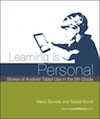Research on Android tablet use in 5th grade classrooms

The series of research projects on tablet use in schools (see here, here and here) now also has an Android study.
A small research project by Marie Bjerede and Tzaddi Bondi, equipped a 5th grade class of 27 students in Portland, Oregon (USA) with 7-inch Samsung Galaxy Tab devices with mobile broadband data to use for learning as well as for their own purposes. Though there were a number of technical issues the results were overwhelmingly positive with greater student engagement.
Below are some of the conclusions, observations, and opinions:
Surprisingly, the quality of student writing on 7-inch tablets and on netbooks was essentially equivalent. Student preferences, however, regarding which device to use for creating content varied. In general, though, students prefer to use laptops for large projects (e.g. content that requires substantial editing) and mobile devices for quick notes (e.g. content that requires essentially no editing at the time it is created).
For the purposes of writing, mobile devices share many of the limitations of writing with pencil and paper – it is linear and cumbersome to edit, though fairly straightforward to create. Although mobile devices are great for capturing pictures, video, voice and even draft writing, laptops with their bigger screens and keyboards and mature software are at an advantage for editing and polishing large projects as well as at combining multiple media.
Although Android devices have a number of desirable qualities, including a lower cost and an open ecosystem for apps, the relative immaturity of the Android ecosystem prevents us from being able to recommend Android devices for school implementations at this time. There is no guarantee of backward compatibility – that new apps will work on older devices. Though this is also beginning to be true in the iOS ecosystem, the problem there is much smaller as there are far fewer operational devices not running the most current version of iOS. Also, since the Android operating system, the hardware, the vendors, and the communications providers are separate organizations, there is no single organization responsible for the whole system as sold, making it cumbersome for educational institutions to manage successfully on their own.
Some of the concerns discussed regarding the use of mobile devices for students strike us as red herrings. In practice, we found no need for device management software as students took ownership of their devices, their learning, and the management of their device images. We found students became savvy and safe Internet users when exposed to authentic Internet user experiences (though social networking happened only within a secure, teacher-managed platform). We found students quickly established a culture of responsible use of their devices, which seemed to enhance their learning rather than distracting them from it. We noticed students becoming confident of hardware and software obstacles, turning first to each other for support and generally finding answers within their classroom community or online.
We observed an organic shift in educators’ approach to teaching, transitioning from primarily preparing and delivering content to the class to an environment where students independently seek out content and contribute it to ongoing classroom discussion. The outcome was a culture where the educator and students learned together, and from each other. We believe that two conditions were essential for this shift: first, that each student had his or her own, connected device that was used for personal purposes as well as for classroom learning; second, the classroom learning culture supported the students’ individual freedom (and responsibility) to explore and experiment, permitting them to decide how to best use the devices to support their learning in the 5th grade.
We found that students independently chose to use their devices in “snippets of time†for math, spelling, word games, reading, and other educational uses that matched their interest, level, and pace. In effect, the students essentially eliminated down time from their day while self-differentiating their learning.
Over the course of the year, the students developed skills and habits in using the tools and resources available through their mobile devices. In their culminating project, a presentation of a colonial trade, the implications of those skills became apparent in project work that was significantly richer, more complex, and more sophisticated than that of students in prior years.



